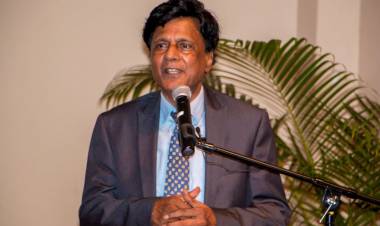Manifestos and voting in Guyana
By: Ravi Dev
The release of manifestos is as much a part of the Guyanese electoral scene as “bottom house meetings”: both are geared to persuade the voting public where to put their X’s on elections day.
With the former, the party offers in writing a “plaster for every sore” that afflicts the body politic but hopefully imbued with an overarching, comprehensive vision. “Bottom house” meetings, are more about informing the party faithful why not to vote for other parties and are generally no-hold-barred affairs, exemplified, for instance, by PNC Chair Volda Lawrence’s comment that “her friends are PNC people and she’ll only give them ‘wuk’”.
Like most of our practices, our manifestos hark back to the European/British origins of our institutions – especially after WWII when the pioneering PPP was launched. The programmatic approach came out of the radical leftist politicians’ insistence that “root and branch” changes were needed across the spectrum to deliver a “brave new world”.
In Britain, the Labour Party shocked the Conservatives – with Churchill at their head – and in 1953, the PPP did the same to the older political formations here. Manifestos became de rigueur from then.
Generally, there are three aspects to manifestos: intra-party purposes, electoral purposes, and governance purposes. Parties typically have dedicated manifesto committees that solicit views from within and without the party, but ultimately the manifesto is ratified by the party. This intra-party process was critical when ideology dominated our political scene and consensus had to be reached among the various “wings” of the party on policy issues.
In 1955, Burnham, for instance, split from the PPP to eventually form the PNC, because he claimed that Jagan and his followers were too “leftist”.
But the disappearance of ideological differences between the PPP and PNC after 1989 – when the neo-liberal premises of the “Washington Consensus” were accepted (however reluctantly) by both parties, raises the question of the relative importance of what are called “valency” versus “position issues” in reference to the “electoral purposes” of manifestos.
The term “valence” is used to highlight the significance of consensual issues – those on which there is agreement on the ends of politics by the parties, such as lower crime or economic growth or corruption. This is contrasted to “position” issues, on which voters and parties are divided on the ends of politics – such as delivering economic growth through Government intervention into the economy versus the present market fundamentalism.
From the comparison of the PPP manifesto versus the last one from APNU/AFC, there has clearly been a convergence of the two parties on “valency” issues: they both declare, in effect, they want to deliver “the good life” as represented by the western democracies.
So how do we choose between them? In Guyana, it has been generally conceded that voting is overwhelmingly influenced by the ethnic origins of voters: one commentator had aptly dubbed our elections as “ethnic censuses”. But if that is so, what exactly will manifestos – which describe the precise policies the parties will take to deliver the “good life” – do?
The manifesto is supposed to convince electors – especially erstwhile ethnic supporters of another party – of the greater competence of the said party to deliver the “goods” they all agree on.
Between 2006 and 2011, for instance, the AFC was able to pull ethnic voters from both the PPP and the PNC because they convinced those voters they were more credible on the valency issues of corruption, security, rice and sugar wages etc, through their strategy of “holding a balance” between the PPP and PNC in the National Assembly.
When they merged with the PNC in 2015, it is conjectured that the AFC brought, as promised, their “Indian” support into the coalition to carry them over the tape. Some saw this as a positive step in Guyanese politics since an African-dominated Government had the opportunity to demonstrate it could move away from ethnic clientelistic politics and bring the “good life” to all ethnic groups.
Its blatantly partisan appointment policies immediately upon taking office, however, followed by its callous treatment of sugar workers, destroyed that hope.
It is up to the PPP to convince the majority of the electorate that it is more competent to deliver the consensus valency issues than the PNC-led coalition for governance purposes since the manifesto now becomes a social contract with the entire populace.






















